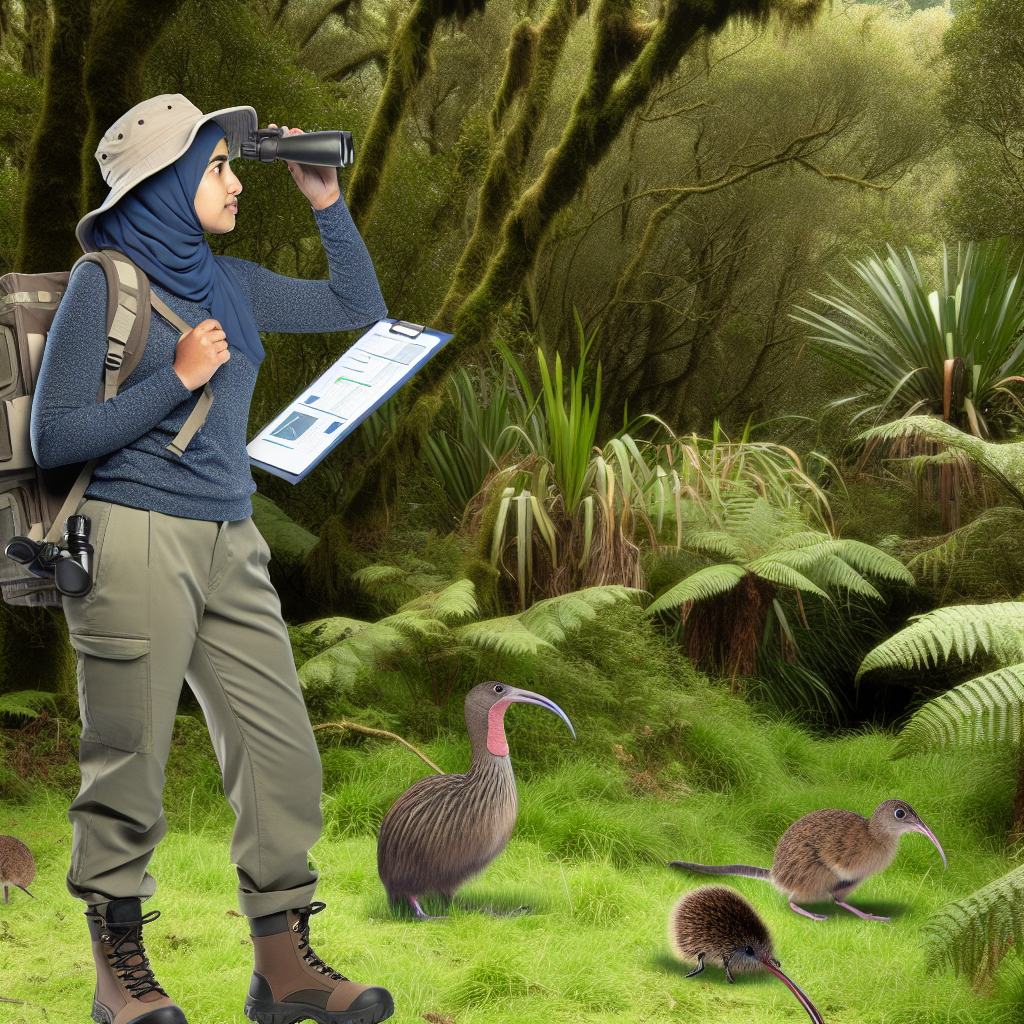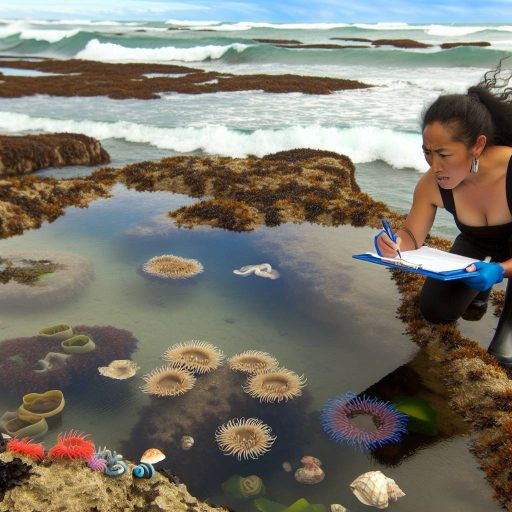Overview of Wildlife Research in New Zealand
Scope of Wildlife Research
Wildlife research in New Zealand encompasses various animal and plant species.
This research plays a crucial role in understanding ecosystems.
Additionally, it aids in monitoring the health of native species.
Moreover, researchers investigate the impact of invasive species.
These studies help formulate effective conservation strategies.
Furthermore, wildlife research informs government policy and practice.
Importance of Wildlife Research
New Zealand’s unique biodiversity is at risk from various threats.
Consequently, conservation efforts are essential for preserving this heritage.
Wildlife researchers contribute valuable data to global conservation efforts.
For example, studies on the kiwi population guide breeding programs.
Furthermore, research on marine life enhances protection measures for oceans.
Ultimately, safeguarding wildlife ensures ecological balance and resilience.
Careers in Wildlife Research
Wildlife research offers diverse career paths for dedicated individuals.
Many researchers work in academia, conducting fundamental studies.
Others focus on applied research in governmental and non-profit organizations.
Personalized Career Consulting
Unlock your potential with expert career advice tailored to your goals. Get personalized guidance and actionable steps toward your dream career in New Zealand.
Get StartedSome professionals engage in fieldwork, collecting vital data in natural habitats.
Moreover, many researchers collaborate with local communities on conservation efforts.
Overall, careers in wildlife research are critical for sustaining biodiversity.
Key Species of Interest
Endemic Flora of New Zealand
New Zealand hosts unique plant species found nowhere else on Earth.
For instance, the iconic Kauri tree stands as a symbol of the ancient forests.
This tree can grow over 50 meters tall, featuring a massive trunk.
The Podocarp family, including Rimu and Totara, thrives in these environments.
Another noteworthy plant is the Silver Fern, recognized internationally.
These ferns are imbued with cultural significance for Māori people.
Conservation efforts target these endemic plant species to prevent extinction.
Unique Fauna of New Zealand
New Zealand’s fauna includes intriguing bird species crucial to its ecosystem.
The Kiwi bird is perhaps the most famous, being a national symbol.
It lays one of the largest eggs relative to its body size.
Additionally, the Kākāpō is a flightless parrot facing severe endangerment.
Transform Your Career with a Professional CV and Cover Letter
Stand out to employers with an ATS-optimized resume and tailored cover letter designed to match your dream role. Let us craft your job application materials for success!
Get StartedThis bird’s recovery program involves innovative breeding strategies.
The rare Hoiho, or Yellow-eyed Penguin, also captures conservationists’ attention.
Efforts aim to restore its populations in their natural habitats.
Importance of Biodiversity
Biodiversity is vital for ecosystem health and resilience.
Each species plays a unique role, contributing to ecological balance.
Preserving native species ensures the continuity of local ecosystems.
Moreover, unique flora and fauna attract ecotourism, aiding the economy.
Conservation research focuses on understanding and protecting these species.
Collaboration among researchers, local communities, and governments is essential.
Innovative conservation strategies improve the chances of species survival.
Career Paths in Wildlife Research
Exploring Field Studies
Field studies remain vital for wildlife researchers.
They often involve direct observation of animals in their habitats.
Researchers might track migration patterns or mating behaviors.
Collecting data in the field requires robust planning and equipment.
Boost Your Career with a Standout LinkedIn Profile
Attract recruiters and expand your network with a fully optimized LinkedIn profile tailored to highlight your strengths and professional goals. Let your profile open doors to new opportunities!
Get OptimizedMoreover, teamwork plays a significant role in these endeavors.
Collaborating with local communities enhances research contributions.
For instance, engaging indigenous populations provides valuable insights.
Researchers such as Emma Davidson focus on the behavior of endangered species.
These insights guide conservation efforts and policy-making.
Diving into Laboratory Work
Laboratory work complements field studies effectively.
It involves analyzing samples collected from various environments.
Researchers often study genetics, disease, and ecology in laboratories.
Advanced technology aids in understanding complex biological processes.
For example, genetic testing can reveal population health trends.
Researchers like Liam Thompson specialize in microbiology related to wildlife.
The information gathered here informs conservation strategies.
Additionally, laboratory findings can lead to innovative solutions.
Specializing in Conservation Policy
Another career path involves developing conservation policies.
This role focuses on the implementation of research findings into policy.
Experts like Sarah Patel advocate for sustainable practices.
They collaborate with government agencies and NGOs for effective policies.
Gathering stakeholder input is critical in this process.
Moreover, public education and awareness campaigns enhance conservation efforts.
These initiatives lead to supportive community engagement.
Integrating Technology in Wildlife Research
Technology significantly enhances wildlife research methodologies.
Researchers utilize drones for aerial surveys and tracking.
Remote sensing tools provide data on habitat changes and threats.
Additionally, camera traps help monitor elusive species.
For instance, Greg Anderson uses technology to study large mammals.
Such innovations allow for efficient data collection and analysis.
Integrating technology fosters more accurate research outcomes.
Learn More: Marine Biologists in NZ: Protecting the Future of Our Oceans
Essential Skills and Qualifications for Aspiring Wildlife Researchers
Academic Background
A strong educational foundation is crucial for wildlife researchers.
A degree in biology, ecology, or environmental science is often essential.
Many positions require advanced degrees, such as a master’s or Ph.D.
Courses in wildlife management and conservation biology are highly beneficial.
Additionally, coursework in statistics can enhance research capabilities.
Technical Skills
Wildlife researchers should be proficient in field research techniques.
They often use GPS, camera traps, and other tracking technologies.
Familiarity with data analysis software is required for statistical analysis.
Moreover, strong proficiency in scientific writing and reporting is necessary.
Researchers must effectively communicate their findings to diverse audiences.
Field Experience
Hands-on experience in wildlife research is invaluable for aspiring researchers.
Internships or volunteer positions provide essential skills and exposure.
Fieldwork often involves capturing, handling, and observing wildlife.
Networking with professionals in conservation can also open doors.
Field experience builds confidence and practical knowledge.
Soft Skills
Effective communication is crucial in wildlife research roles.
Researchers often collaborate with teams and stakeholders.
They must convey complex data in an understandable manner.
Additionally, problem-solving skills are essential for overcoming challenges.
Being adaptable in dynamic environments is also highly valued.
Certifications and Licenses
Some wildlife research positions may require certifications.
A wildlife rehabilitation certification can enhance job prospects.
First aid and CPR certifications are often beneficial for fieldwork.
Knowledge of local laws pertaining to wildlife protection is important.
Additionally, licenses for specific research methods may be necessary.
Delve into the Subject: The Role of Climate Scientists in Protecting New Zealand’s Ecosystem
Major Conservation Initiatives and Organizations in New Zealand
Introduction to Conservation Efforts
New Zealand is renowned for its unique wildlife and diverse ecosystems.
Conservation initiatives aim to protect and restore these natural treasures.
Moreover, various organizations lead these crucial efforts across the country.
Department of Conservation (DOC)
The Department of Conservation plays a pivotal role in wildlife preservation.
DOC manages national parks, reserves, and marine protected areas.
This organization coordinates efforts to rehabilitate endangered species.
Furthermore, DOC promotes education about biodiversity conservation.
Forest and Bird
Forest and Bird is one of New Zealand’s key conservation groups.
This organization focuses on protecting native flora and fauna.
They advocate for environmental policies and restoration projects.
Additionally, Forest and Bird engages local communities in conservation activities.
Te Runanga o Ngai Tahu
Te Runanga o Ngai Tahu actively participates in conservation efforts.
This iwi (tribe) emphasizes protecting natural resources integral to their culture.
They collaborate with governmental bodies on various conservation projects.
Moreover, they promote the sustainable use of lands and waters.
Wildlife Rehabilitation Groups
Numerous wildlife rehabilitation groups operate across New Zealand.
These organizations provide care for injured and orphaned wildlife.
They strive to rehabilitate animals back into their natural habitats.
Additionally, they focus on educating the public about wildlife protection.
Ecotourism Initiatives
Ecotourism initiatives contribute significantly to conservation funding.
These programs promote sustainable travel while supporting local wildlife habitats.
Visitors can engage in responsible wildlife viewing opportunities.
As a result, ecotourism helps raise awareness about conservation issues.
Collaborative Conservation Projects
Collaboration between various organizations enhances conservation outcomes.
These partnerships often lead to successful restoration efforts.
Community involvement is crucial for the success of these projects.
Moreover, integrating traditional ecological knowledge proves beneficial.
Uncover the Details: How Genetic Research Will Shape Healthcare in NZ
Challenges Facing Wildlife Researchers
Climate Change Impacts
Climate change significantly affects wildlife populations across New Zealand.
Researchers observe these changes in migration patterns and breeding cycles.
Extreme weather events alter habitats and food availability for many species.
This creates an urgent need for adaptive research strategies.
Habitat Loss Concerns
Human activities lead to significant habitat destruction in New Zealand.
Urban development and agriculture fragment natural environments.
Consequently, wildlife researchers must assess the impact on biodiversity.
Efforts to restore habitats become increasingly essential.
Invasive Species Challenges
Invasive species pose a substantial threat to native wildlife.
They compete for resources and disrupt local ecosystems.
Wildlife researchers study how to mitigate these impacts effectively.
Implementing control measures requires collaborative efforts across sectors.
Funding and Resource Limitations
Funding is a persistent challenge for wildlife research initiatives.
Many researchers rely on grants and donations to sustain their work.
Limited resources can hinder comprehensive research projects.
Striking partnerships can enhance funding opportunities significantly.
Public Engagement and Education
Engaging the public is crucial for wildlife conservation efforts.
Awareness of conservation issues fosters community support.
Researchers often conduct workshops and outreach programs to educate the public.
Informed communities are essential for successful conservation strategies.
Uncover the Details: High-Impact Science Jobs in NZ for Future Innovators

Success Stories: Impactful Wildlife Research Projects in NZ
Conservation of the Kiwi Bird
Kiwi birds are iconic to New Zealand’s wildlife.
Researchers from the Kiwi Recovery Programme focus on their protection.
This project helps to restore the population of these flightless birds.
Through monitoring, researchers identify threats like predators.
Innovative breeding programs increase their numbers significantly.
Monitoring Dolphin Populations
New Zealand is home to unique dolphin species.
The Project Kaitiaki aims to study and protect these marine mammals.
Researchers gather data on dolphin behavior and population dynamics.
This information helps inform conservation management strategies.
The project collaborates with local communities for shared successes.
Protecting the Hoiho (Yellow-Eyed Penguin)
The Hoiho is one of the rarest penguin species in the world.
Researchers conduct monitoring efforts along the Otago Peninsula.
They assess habitat conditions and breeding success rates.
Public awareness campaigns educate locals on conservation efforts.
Password-protected reserves help shield nesting sites from disturbance.
Fox Management in the South Island
The South Island’s unique fauna often faces threats from invasive species.
The Fox Management Programme addresses these challenges aggressively.
Researchers employ trap monitoring and control measures effectively.
This strategy aims to protect native bird populations and ecosystems.
Community involvement enhances the reach and effectiveness of initiatives.
Invasive Species Research
Invasive species significantly threaten New Zealand’s biodiversity.
The Invasive Species Research Program conducts vital investigations.
Researchers analyze the impacts of species like possums and rats.
They develop and promote effective management solutions.
Collaborations with NGOs bolster these efforts nationwide.
Long-Term Ecological Monitoring
Long-term ecological monitoring offers critical insights.
The Terrestrial Ecosystems Monitoring project assesses environmental changes.
This research collects invaluable data on site conditions over time.
Understanding trends helps in conservation planning and policy making.
Ongoing partnerships with universities enhance research capabilities.
Future Trends in Wildlife Research: Technology and Citizen Science
The Role of Technology in Wildlife Research
Technology plays a crucial role in advancing wildlife research.
Innovative tools enhance data collection and analysis.
For instance, drones are now common in wildlife monitoring.
They provide aerial views and gather information quickly.
Camera traps also help document animal behavior effectively.
Furthermore, GPS collars offer insights into movement patterns.
These devices track animals over vast territories.
Additionally, researchers employ remote sensing technologies.
This method assesses habitat changes and environmental impacts.
As technology progresses, data accuracy and efficiency improve.
Citizen Science: Engaging the Public
Citizen science involves the public in wildlife research.
This approach helps gather large volumes of data.
People contribute observations through mobile applications.
One such platform is iNaturalist, popular among nature enthusiasts.
It encourages users to identify and record species.
Moreover, community-based programs foster local conservation efforts.
These initiatives boost awareness about wildlife issues.
They also nurture a culture of environmental stewardship.
Collaboration between scientists and citizens strengthens research outcomes.
Furthermore, it creates a more informed public discussion about conservation.
Future Innovations in Wildlife Research
Future innovations are likely to transform wildlife research further.
Artificial intelligence will assist in data processing and analysis.
This technology can identify patterns in large datasets.
Moreover, machine learning algorithms improve prediction capabilities.
Researchers may also harness blockchain for data integrity.
This ensures transparency and reliability in shared data.
Collaborative platforms will facilitate better communication.
These developments will enhance the impact of conservation efforts.
Overall, a combination of technology and citizen science drives progress.
Urgent action and innovation are essential for wildlife preservation.
Networking and Professional Development Opportunities for Wildlife Researchers in NZ
Establishing Professional Networks
Wildlife researchers in New Zealand benefit greatly from establishing professional networks.
These connections enhance collaboration among scientists and organizations.
Conferences such as the New Zealand Ecological Society Meeting encourage networking.
Researchers can gain valuable insights and share findings at these events.
Additionally, organizations like the Department of Conservation host workshops.
These workshops focus on specific research topics and conservation strategies.
Participating in Conferences and Workshops
Conferences provide platforms to exchange ideas and disseminate research findings.
Attending national and international conferences expands visibility within the field.
Workshops often include hands-on training in the latest research techniques.
A variety of topics, such as species management and habitat restoration, are covered.
Engagement in these activities fosters a sense of community among researchers.
Joining Professional Organizations
Membership in professional organizations supports career advancement.
Organizations like the New Zealand Wildlife Society offer resources and events.
Members can access funding opportunities for research projects.
Furthermore, organizations often provide mentorship programs.
Mentorship connects early-career researchers with experienced professionals.
Utilizing Online Platforms
Online platforms play a significant role in professional development for wildlife researchers.
Networking sites such as LinkedIn facilitate connections with peers worldwide.
ResearchGate serves as a platform to share research and collaborate.
Webinars and online courses offer learning opportunities on various topics.
Engaging actively on these platforms can lead to new collaboration opportunities.
Participating in Citizen Science Initiatives
Wildlife researchers can enhance their networks by participating in citizen science projects.
These initiatives often involve local communities in data collection and monitoring.
Collaborating with the public can broaden research impact and raise awareness.
Additionally, citizen science fosters relationships with potential future researchers.
Such projects provide valuable hands-on experience for volunteers and researchers alike.
Additional Resources
EcoQuest: Study Abroad in Aotearoa New Zealand | College of Life …
Meet Melissa Marquez, a shark scientist passionate about the …




